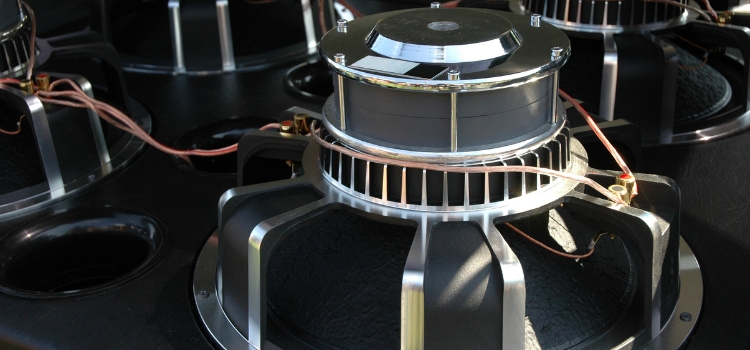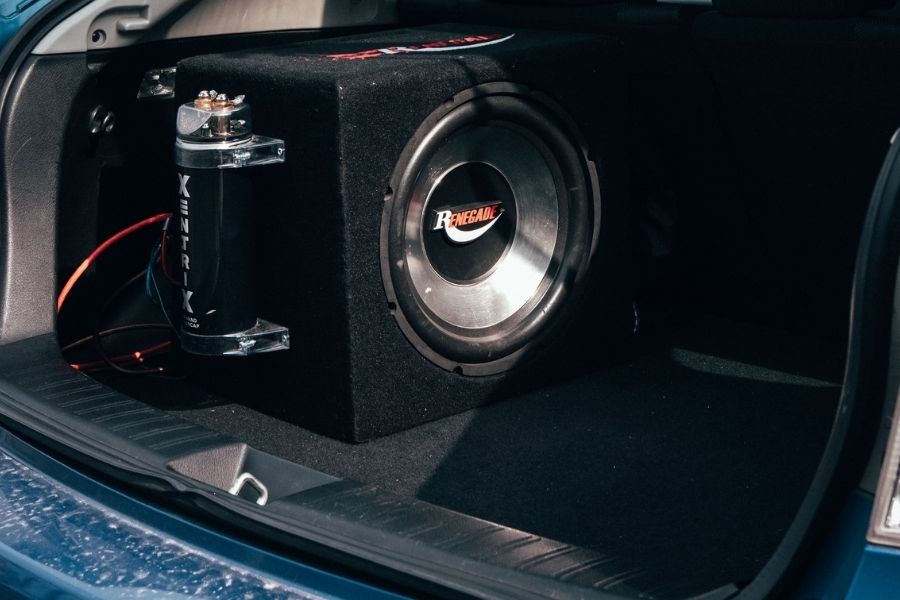Subwoofers and bass management can be complicated at times. We often get the question “Why is my subwoofer bottoming out?” from frustrated readers. When everything is properly set up, subwoofers are a huge value-added to any home or car audio system for quality, loud bass. Sometimes people will experience strange noises from their subwoofer though. So, what does it mean for a sub to bottom out? We’ll break down exactly what it means and how to differentiate it from other noises you might hear. We’ll also cover why your subwoofer is bottoming out and possible fixes. Let’s get started and fix your subwoofer issues!
Table of Contents
What Does It Mean For A Sub To Bottom Out?

Before answering the question, “Why is my subwoofer bottoming out?”, we have to define bottoming out. That starts with a speaker cone’s excursion. The excursion is the distance a speaker cone travels while in motion. A subwoofer’s speaker cone has to move more air than other speakers. This is because of the low frequencies and sub-bass a subwoofer must produce. The excursion of the speaker cone is what allows that air to be moved. Only so much excursion of the speaker cone is necessary or expected though. Too much will result in a subwoofer bottoming out. This is also referred to as over-excursion. When the speaker cone extends too much and hits the bottom (bottoms out) or back of its box. The subwoofer driver is literally being pushed past its mechanical limits.
Why Do Subwoofers Bottom Out?
Why do subs bottom out? Your subwoofer is likely bottoming out because it’s being pushed too hard. A lot of power is required to reproduce low frequencies. Too much power will push the subwoofer beyond its mechanical power handling and physical limitations. What constitutes too much power can be difficult to determine tough. Even certain musical tracks or movie soundtracks will push your subwoofers harder than usual. Power can be part of the issue and is directly related to volume.
Excessive volumes require more power and will push your amplifier toward its peak wattage. With car audio, people often pair subwoofers with external amplifiers. Cranking the volume for loud bass in your car will draw more power. Just turning up the volume for one particular song might cause a subwoofer to bottom out. This is unlike home theater where powered subwoofers are more prevalent. That along with AV receivers and sub pre-outs make the bass management process a little more straightforward.
Bad or mismatched components can also cause bottoming out. Some speaker cones require more excursion based on material and size. The subwoofer box or enclosure must be big enough for this excursion. If it is not, it can also bottom out. This is less likely with an established manufacturer unless the item is defective. Many people, especially for car audio, place their subwoofers in pre-built or custom enclosures. Those into DIY or custom ported subwoofer enclosures should ensure proper port tuning to avoid damaging their speakers.
What Does a Sub Bottoming Out Sound Like?

When that over-excursion or bottoming out happens, it can result in noise. That’s typically the voice coil on the end of the driver physically hitting the back or bottom of the subwoofer box. The material of the speaker cone components will vary, so the sounds can also be different. A hard or soft bottom will also result in slightly different noises. It’s typically a clacking or thumping-like noise as the voice coil and box meet. This does more than hurt the sound quality when it happens. It can slowly damage the speaker cone and deform components. It can even result in the voice coil falling off the speaker cone. You can find an example of a sub bottoming out here.
Subwoofer Port Noise vs. Bottoming Out
Bottoming out should not be confused with subwoofer port noise. Port noise or chuffing from a sub in a ported box can happen if a subwoofer is being pushed too hard. The noise and reasons for port noise are a little different though. Port noise will sound like a whooshing wind. It will also sound out of place with normal audio. Some describe it as a farting-like noise. This is due to excess air being pushed through the subwoofer port. It can also be a result of a ported box with a bad design. A ported box must have a long enough port to allow enough air through.
How To Fix Sub Bottoming Out
Lower Power/Gain
You’ll know more about your audio system and how prevalent the issue is. With that being said, lowering the power or gain on your subwoofer is always a good start. If you are pushing too much power to your subwoofer, it can cause bottoming out. Check the mechanical power handling on your subwoofer to ensure it is matched with the right amplifier. Lowering the power can also be achieved by lowering the power directly on the external amplifier or powered subwoofer panel.
Lower Volume/Don’t Push
This is better advice if the issue is not ongoing. We all love loud bass, but your subwoofer has limits. Fighting the urge to turn the volume all the way can make the difference. Especially for that particular song that forces your subwoofer to work hard with thudding and fast bass. A certain song or soundtrack can really push your subwoofer. For better or worse, certain songs are known to “break subwoofers or blow speakers”. We all know one or two. Part of that equation is how low the frequencies are and how high you crank the volume. A perfect storm of the two can cause your subwoofer to bottom out. We all know you will need a subwoofer to achieve the lowest bass frequencies. But this still requires a lot of power and not all subwoofers are equal. Learn your subwoofer’s limits and adjust your behavior accordingly to avoid issues.
Know Your Subwoofer Components
Ensure you have the correct enclosure for your subwoofer. It’s normal to sometimes buy these separately for car audio. Just make sure the enclosure is large enough for your subwoofer. An 18″ subwoofer needs a different enclosure than a 10″ subwoofer. The proper port tuning has to occur when matching an enclosure with a subwoofer.
It also should be noted that the material used to build subwoofers varies. Some are actually more rigid to prevent over excursion. Those materials often need time to break in before they are pushed hard. Pushing a new subwoofer too hard can actually result in issues down the road. Learning how to break in a subwoofer can help avoid issues going forward.
A subsonic filter should also be considered for car audio enthusiasts who want to push their subwoofers hard. An amplifier’s subsonic filter or infrasonic filter doesn’t completely cut off lower frequencies. It slightly limits very low frequencies without impacting the listening experience. The result is less strain on your amplifier and subwoofer.
Upgrade Your Subwoofer
Subwoofers have a straightforward job, but some are just flat-out better than others. It’s possible you are also asking too much for the subwoofer you have. Are you trying to push your 8″ sub to the max with a powerful external amplifier? You probably need a bigger subwoofer. More expensive subwoofers don’t just handle more power. They also can handle lower frequencies. Most consumer subwoofers won’t have issues with bottoming out when used correctly. They can be pushed too hard though. Understand your goals properly and upgrade if you want a different experience. A damaged subwoofer won’t help anybody.
Final Word on Subwoofers Bottoming Out
It’s always frustrating when you’re not getting the home or car audio experience you wanted. We all love a bass boost, but nobody wants a damaged subwoofer. Understanding why your subwoofer is bottoming out is the first step. Now it’s time to make the fix to get the best audio experience. Hopefully, we’ve given your the tools to do both. Good luck!
Subwoofer Issues: FAQs
What is Subwoofer Over Excursion?
Subwoofer over-excursion happens when a subwoofer is pushed past its physical limits. Speaker excursion is the distance a driver cone travels when in movement. Lower frequencies require more driver excursion than higher frequencies. Subwoofer over-excursion happens when a speaker driver travels further than intended.
How To Break In A Subwoofer?
To break in a subwoofer, simply listen or play music. It can be helpful to listen to music at medium levels for two weeks. This should allow the suspension and rigid cone material time to settle a bit. It’s then safer to listen to music at loud levels and really push your woofer.
Will A Sealed Sub Have Fewer Issues Than One In A Ported Box?
While a sealed subwoofer removes the problem of port noise, it can still bottom out. With proper port tuning, a subwoofer in a ported box will typically produce the lowest frequencies more efficiently. This is why they are preferred for home theater. Sealed subwoofers are thought to provide tighter bass and are preferred by many for music.
What is A Subsonic Filter?
A subsonic filter cuts out super low frequencies and gives your subwoofer some relief. The frequencies that get cut off aren’t often integral to sound quality. It can also remove excess rumbling that can cause unwanted vibrations.

Keith Collins has been writing for over 15 years for various publications. He’s a lover of music, home theater, and excellent sound quality. His fondness for technology in addition to his non-stop curiosity fuels his writing ventures.






